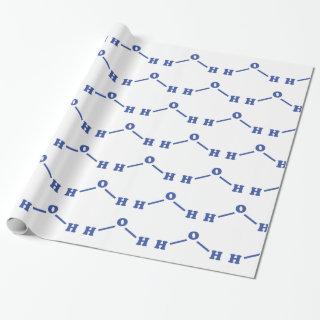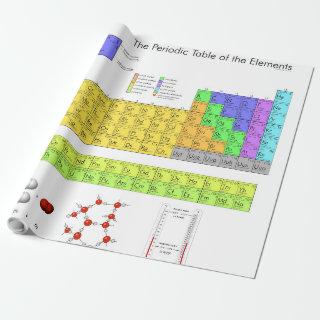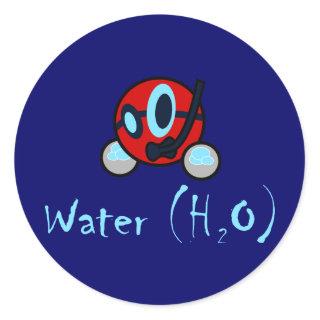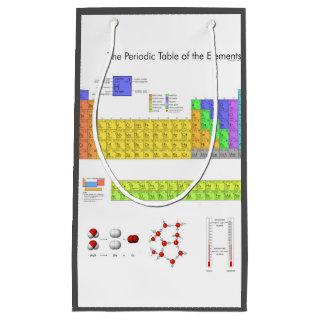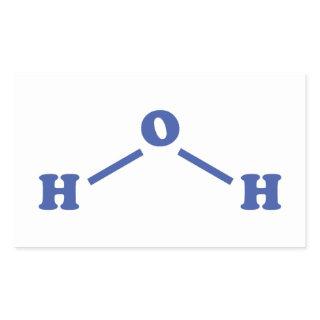Item Description
What is custom wrapping paper?
In the context of this Hydrogen Individual Element of the Periodic Table Square Sticker you get a high-quality paper, printed just for you. But there is more. The periodiс table of the chemical elements (also Mendeleev’s table, periodic table of the elements or just periodic table) is a tabular display of the chemical elements. Although precursors to this table exist, its invention is generally credited to Russian chemist Dmitri Mendeleev in , who intended the table to illustrate recurring (“periodic”) trends in the properties of the elements. The layout of the table has been refined and extended over time, as new elements have been discovered, and new theoretical models have been developed to explain chemical behavior. The periodic table is now ubiquitous within the academic discipline of chemistry, providing an extremely useful framework to classify, systematize, and compare all of the many different forms of chemical behavior. The table has found wide application in chemistry, physics, biology, and engineering, especially chemical engineering. The current standard table contains elements as of July In , Antoine Lavoisier published a list of chemical elements. Although Lavoisier grouped the elements into gases, metals, non-metals, and earths, chemists spent the following century searching for a more precise classification scheme. In , Johann Wolfgang Döbereiner observed that many of the elements could be grouped into triads (groups of three) based on their chemical properties. Lithium, sodium, and potassium, for example, were grouped together as being soft, reactive metals. Döbereiner also observed that, when arranged by atomic weight, the second member of each triad was roughly the average of the first and the third. This became known as the Law of triads.[citation needed] German chemist Leopold Gmelin worked with this system, and by he had identified ten triads, three groups of four, and one group of five. Jean Baptiste Dumas published work in describing relationships between various groups of metals. Although various chemists were able to identify relationships between small groups of elements, they had yet to build one scheme that encompassed them all. German chemist August Kekulé had observed in that carbon has a tendency to bond with other elements in a ratio of one to four. Methane, for example, has one carbon atom and four hydrogen atoms. This concept eventually became known as valency. In , fellow German chemist Julius Lothar Meyer published a table of the known elements arranged by valency. The table revealed that elements with similar properties often shared the same valency. English chemist John Newlands published a series of papers in and that described his attempt at classifying the elements: When listed in order of increasing atomic weight, similar physical and chemical properties recurred at intervals of eight, which he likened to the octaves of music. This law of octaves, however, was ridiculed by his contemporaries.[8] Portrait of Dmitri MendeleevRussian chemistry professor Dmitri Ivanovich Mendeleev and Julius Lothar Meyer independently published their periodic tables in and , respectively. They both constructed their tables in a similar manner: by listing the elements in a row or column in order of atomic weight and starting a new row or column when the characteristics of the elements began to repeat. The success of Mendeleev’s table came from two decisions he made: The first was to leave gaps in the table when it seemed that the corresponding element had not yet been discovered. Mendeleev was not the first chemist to do so, but he went a step further by using the trends in his periodic table to predict the properties of those missing elements, such as gallium and germanium. The second decision was to occasionally ignore the order suggested by the atomic weights and switch adjacent elements, such as cobalt and nickel, to better classify them into chemical families. With the development of theories of atomic structure, it became apparent that Mendeleev had inadvertently listed the elements in order of increasing atomic number. With the development of modern quantum mechanical theories of electron configurations within atoms, it became apparent that each row (or period) in the table corresponded to the filling of a quantum shell of electrons. In Mendeleev’s original table, each period was the same length. However, because larger atoms have more electron sub-shells, modern tables have progressively longer periods further down the table. In the years that followed after Mendeleev published his periodic table, the gaps he left were filled as chemists discovered more chemical elements. The last naturally-occurring element to be discovered was Francium (referred to by Mendeleev as eka-caesium) in . The periodic table has also grown with the addition of synthetic and transuranic elements. The first transuranic element to be discovered was neptunium, which was formed by bombarding uranium with neutrons in a cyclotron in “Periodic Table of Elements” Periodic Table of Elements Dmitri Mendeleev Antoine Lavoisier Chemist Chemicals Chemistry Physics Lab Laboratory Experiment Experiments Chart Poster August Kekulé Organic Physical Analytical Biochemist Biochemistry Biochemical Biological Biology Biologist Compound Compounds Molecule Molecular Mole Avogadro Formula Symbol “Chemical Symbol” Atom Atomic “Atomic Weight” Proton Neutron Electron Deuterium Tritium Isotope Isomer Molarity Radioactive Nucleus Orbital Spin Quantum Row Period Actinium Aluminum Americium Antimony Argon Arsenic Astatine Barium Berkelium Beryllium Bismuth Bohrium Boron Bromine Cadmium Calcium Californium Carbon Cerium Cesium Chlorine Chromium Cobalt Copper Curium Darmstadtium Dubnium Dysprosium Einsteinium Erbium Europium Fermium Fluorine Francium Gadolinium Gallium Germanium Gold Hafnium Hassium Helium Holmium Hydrogen Indium Iodine Iridium Iron Krypton Lawrencium Lead Lithium Lutetium Magnesium Manganese Meitnerium Mendelevium Mercury Molybdenum Neodymium Neon Neptunium Nickel Niobium Nitrogen Nobelium Osmium Oxygen Palladium Phosphorus Platinum Plutonium Polonium Potassium Praseodymium Promethium Protactinium Radium Radon Rhenium Rhodium Rubidium Ruthenium Rutherfordium Samarium Scandium Seaborgium Selenium Silicon Silver Sodium Strontium Sulfur Tantalum Technetium Tellurium Terbium Thallium Thorium Thulium TinTitanium Tungsten Ununbium Ununnilium Ununumium Uranium Vanadium Xenon Ytterbium Yttrium Zinc Zirconium
When you create a custom sheet of gift wrap you are doing more than adding that final touch, you’re making lasting memories and showing the recipient that you were really thinking of them when you prepared the present.
Find Similar Items
We love this design, but it isn’t alone. If you are looking for more options, here are a couple of similar searches that match this Hydrogen Individual Element of the Periodic Table Square Sticker. View the related searches to find great, one of a kind, gift wrap ideas for your next celebration!
hydrogen, periodic, table, elements, iupac, dmitri, mendeleev, chemistry, physics, lab, laboratory, experiment, chart, poster, kekulé, organic, physical, analytical, biochemistry, biology
Related Products
Here are some designs that you may also like. Our editors have been busy making sure that you get exactly what you want when you choose a-wrap.com as your source for gift wrap. These designs are craft to give you flexibility when it comes time to gift your next present. From funny personalized designs, to those with photos, your options are only limited by your imagination. Gifting has never been more fun and rewarding that now!
Discounts You Can Appreciate
Just because your gift get elevated to the next level when you design your own wrapping paper doesn’t mean you need to spend a lot. In fact much of the offering you will fine on the site is comparable with other high-quality paper. But there is one special difference. When you order more than one set (sets come with three sheets) you qualify for a special discounted price.
Discount Brackets
Curious what you can save? Here are the price brackets when you order multiple copies of wrapping paper. These discounts are ideal for everyone, discounts begin after two sets and go all the way up to 30% off when you order the corporate package.
- 2 Sets (Save 5%)
- 3-4 Sets (Save 10%)
- 5-10 Sets (Save 15%)
- 15-20 Sets (Save 20%)
- 25+ Sets (Save 25%)
- 35+ Sets (Save 30%)

